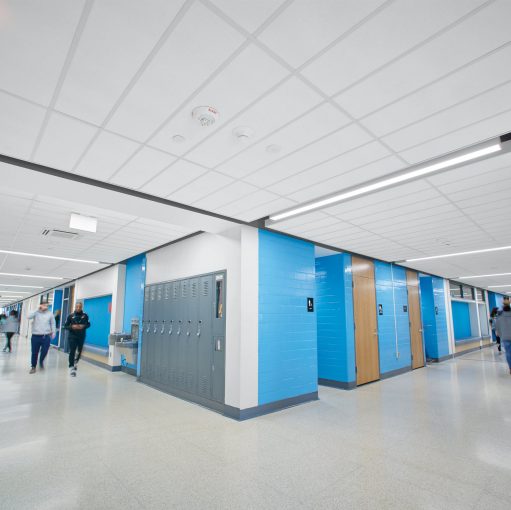Addressing Embodied Carbon In The Built Environment
Construction materials generate over 11% of worldwide greenhouse gas emissions. According to Architecture 2030 the building sector must reduce carbon emissions 65% by 2030, quickly followed by getting to zero emissions by 2040* to avoid triggering irreversible climate change.
Cutting carbon has never been easier. Below is a list of carbon-reduction strategies you can use on your projects.
Limiting Embodied Carbon In The Built Environment

1. Select Partners with Green Building Reduction Strategies
Armstrong SUSTAIN products contribute to Green Building Carbon reduction strategies.
- LEEDv4 Projects: Armstrong SUSTAIN products contribute to Material and Resources Credit
- LBC Net Zero Certification: Armstrong has solutions to contribute to energy efficiency strategies

2. Select Products with Current EPDs
Armstrong Environmental Product Declarations detail the Embodied Carbon on all our major acoustical ceiling panels, suspension systems, and specialty products. We are committed to transparency in the carbon impacts of our material ingredients. We are proud to announce that several Armstrong products have shown embodied reductions in our latest round of EPD documentation.

3. Select Products with Lowest Embodied Carbon
Compare Armstrong Products on the EC3 tool, which reports stages A1-A3 (cradle-to-gate) impacts of a single product. Armstrong mineral fiber ceiling products fall within the range of .262 to .842kgCO2e/ft2, far below the Ceiling Industry Baseline of 1.30kgCO2e/ft2.

4. Select Products with High Recycled Content
Selecting materials with increased recycled content reduces emissions associated with virgin raw materials. Armstrong products have recycled content ranging from 20% to 85%, which makes Armstrong ceilings an ideal low-carbon finish.
5. Recycling Saves Carbon
Lower your carbon footprint by diverting construction waste and contributing to recycling streams for new products. For each square foot of ceilings returned through the Armstrong Ceilings Recycling Program, you can save .228 kg CO2 equivalent.

6. Design with Pre-engineered Solutions
Get greater design control and save time, labor, and carbon emissions with pre-engineered solutions. From window and shade pockets to trims and soffits, light coves, and curved ceiling applications, Armstrong offers many prefabricated, modular solutions for common conditions, while also offering embodied carbon reductions from 70-75% over traditional installation methods.

7. Design with FRAMEALL Drywall Grid Over Stud & Track
Armstrong FRAMEALL Drywall Grid delivers up to a 76% reduction in carbon over traditional framing systems by eliminating the need for extra framing, and on-center frequency. FRAMEALL Drywall Grid is lightweight, contains recycled content, and uses less material–all contributing to a significant reduction in embodied carbon. Finishing with ACOUSTIBUILT Seamless Acoustical Ceiling and Wall system for even more savings than standard drywall.

8. Heat & Cool with Radiant Metal Ceiling Systems
Save energy and reduce operational carbon with METALWORKS AIRTITE radiant ceiling systems. This circulates hot or cold water through concealed copper tubing providing sustainable heating and cooling with minimal air ventilation requirements.

9. Include Ceilings in Designs for Building Efficiency
ACT and suspension systems are designed for material efficiency, durability, and flexibility and incur minimal waste due to panelized designs. These systems are designed for disassembly, contributing to greater potential for deconstruction and recycling.

10. Design to Use Less Material
Armstrong Ceiling & Wall Solutions allow for less material with integrated solutions, panelized systems, and exposed structure ceiling options like clouds and canopies or vertical solutions like baffles and blades.